Darwin, MN Map & Demographics
Darwin Map
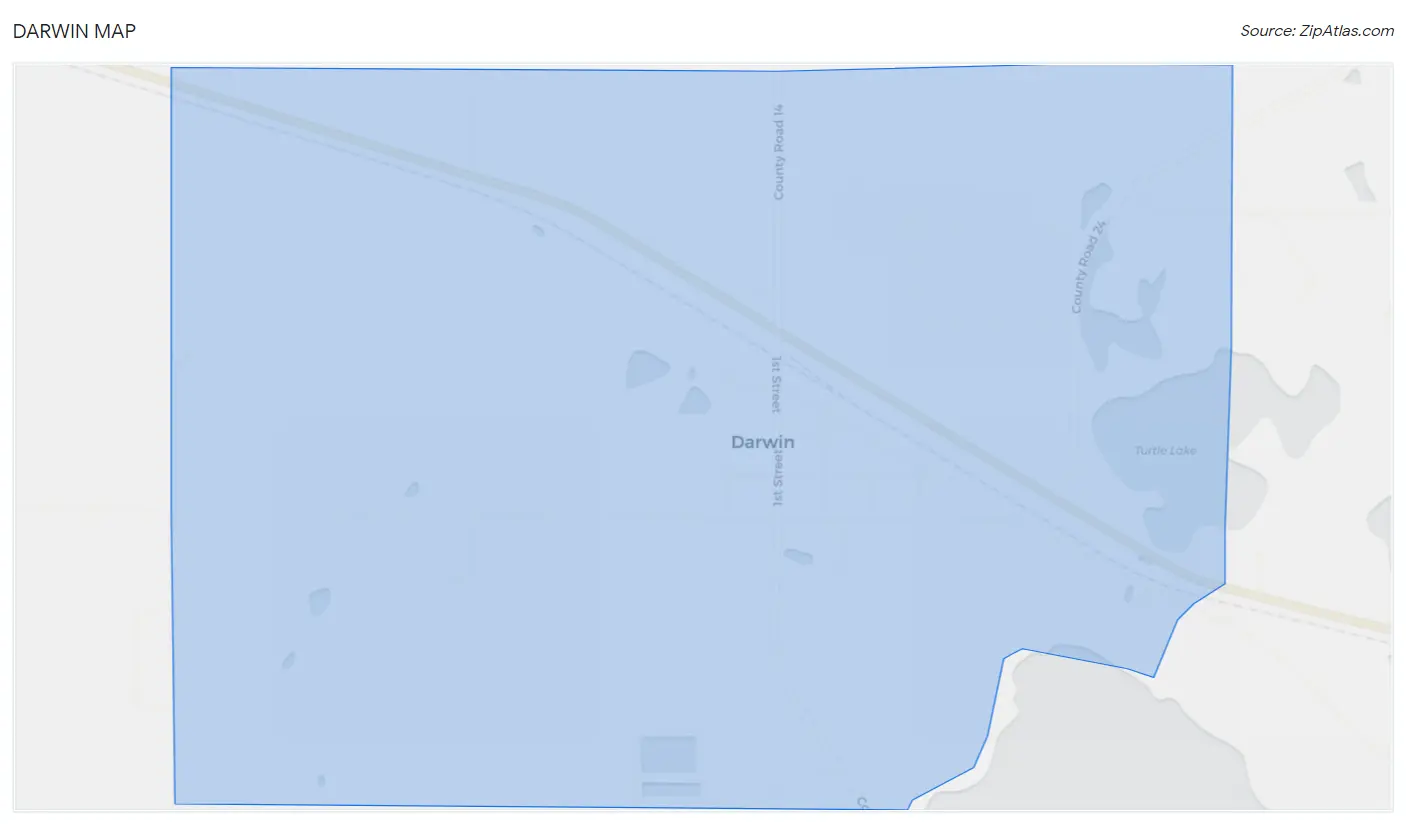
Darwin Overview
$32,788
PER CAPITA INCOME
$95,625
AVG FAMILY INCOME
$62,083
AVG HOUSEHOLD INCOME
54.4%
WAGE / INCOME GAP [ % ]
45.6¢/ $1
WAGE / INCOME GAP [ $ ]
0.40
INEQUALITY / GINI INDEX
377
TOTAL POPULATION
209
MALE POPULATION
168
FEMALE POPULATION
124.40
MALES / 100 FEMALES
80.38
FEMALES / 100 MALES
34.8
MEDIAN AGE
3.6
AVG FAMILY SIZE
2.7
AVG HOUSEHOLD SIZE
200
LABOR FORCE [ PEOPLE ]
69.9%
PERCENT IN LABOR FORCE
6.5%
UNEMPLOYMENT RATE
Darwin Zip Codes
Darwin Area Codes
Income in Darwin
Income Overview in Darwin
Per Capita Income in Darwin is $32,788, while median incomes of families and households are $95,625 and $62,083 respectively.
| Characteristic | Number | Measure |
| Per Capita Income | 377 | $32,788 |
| Median Family Income | 83 | $95,625 |
| Mean Family Income | 83 | $103,349 |
| Median Household Income | 141 | $62,083 |
| Mean Household Income | 141 | $82,879 |
| Income Deficit | 83 | $0 |
| Wage / Income Gap (%) | 377 | 54.41% |
| Wage / Income Gap ($) | 377 | 45.59¢ per $1 |
| Gini / Inequality Index | 377 | 0.40 |
Earnings by Sex in Darwin
Average Earnings in Darwin are $50,481, $57,969 for men and $26,429 for women, a difference of 54.4%.

| Sex | Number | Average Earnings |
| Male | 113 (54.6%) | $57,969 |
| Female | 94 (45.4%) | $26,429 |
| Total | 207 (100.0%) | $50,481 |
Earnings by Sex by Income Bracket in Darwin
The most common earnings brackets in Darwin are $55,000 to $64,999 for men (25 | 22.1%) and $55,000 to $64,999 for women (12 | 12.8%).
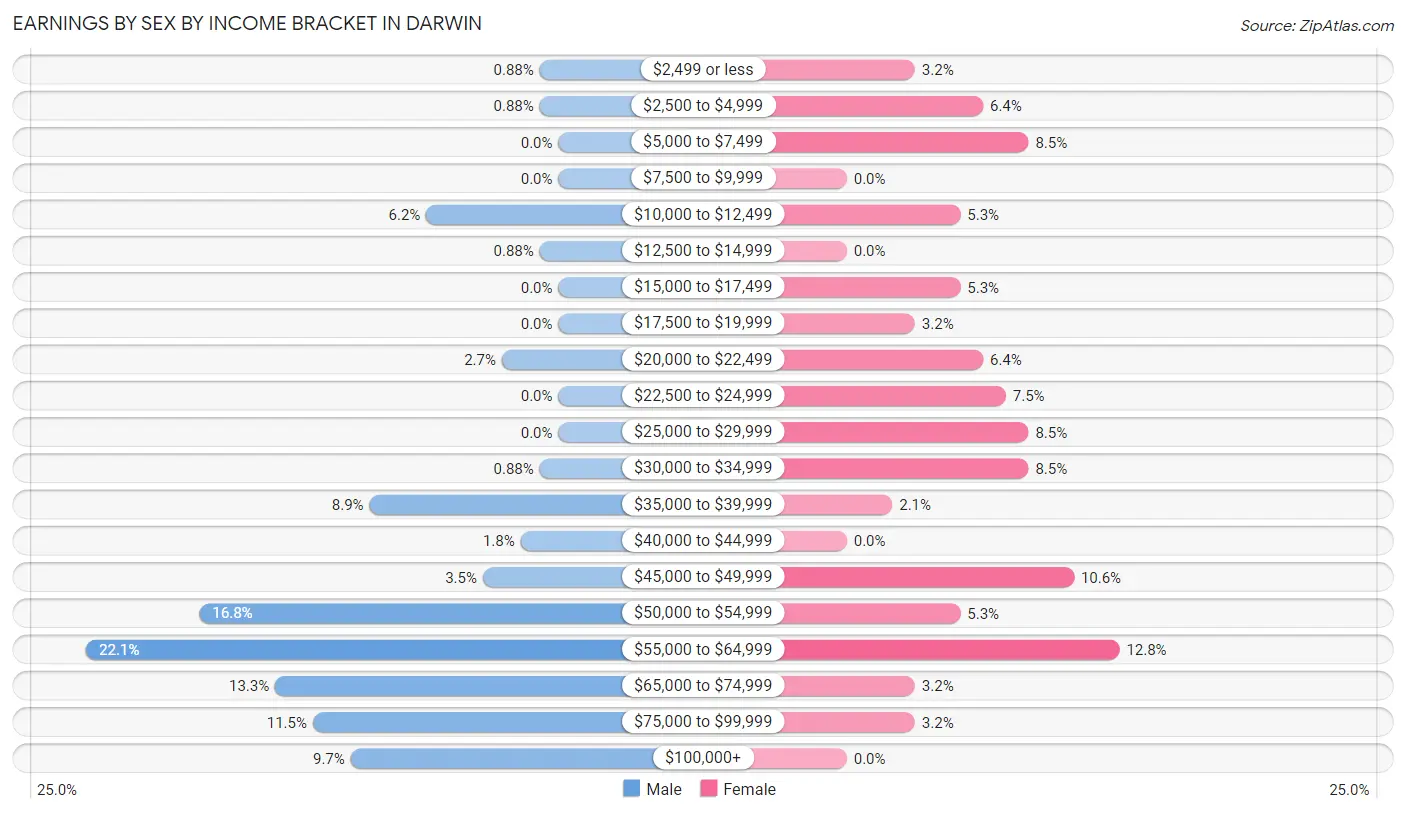
| Income | Male | Female |
| $2,499 or less | 1 (0.9%) | 3 (3.2%) |
| $2,500 to $4,999 | 1 (0.9%) | 6 (6.4%) |
| $5,000 to $7,499 | 0 (0.0%) | 8 (8.5%) |
| $7,500 to $9,999 | 0 (0.0%) | 0 (0.0%) |
| $10,000 to $12,499 | 7 (6.2%) | 5 (5.3%) |
| $12,500 to $14,999 | 1 (0.9%) | 0 (0.0%) |
| $15,000 to $17,499 | 0 (0.0%) | 5 (5.3%) |
| $17,500 to $19,999 | 0 (0.0%) | 3 (3.2%) |
| $20,000 to $22,499 | 3 (2.6%) | 6 (6.4%) |
| $22,500 to $24,999 | 0 (0.0%) | 7 (7.4%) |
| $25,000 to $29,999 | 0 (0.0%) | 8 (8.5%) |
| $30,000 to $34,999 | 1 (0.9%) | 8 (8.5%) |
| $35,000 to $39,999 | 10 (8.8%) | 2 (2.1%) |
| $40,000 to $44,999 | 2 (1.8%) | 0 (0.0%) |
| $45,000 to $49,999 | 4 (3.5%) | 10 (10.6%) |
| $50,000 to $54,999 | 19 (16.8%) | 5 (5.3%) |
| $55,000 to $64,999 | 25 (22.1%) | 12 (12.8%) |
| $65,000 to $74,999 | 15 (13.3%) | 3 (3.2%) |
| $75,000 to $99,999 | 13 (11.5%) | 3 (3.2%) |
| $100,000+ | 11 (9.7%) | 0 (0.0%) |
| Total | 113 (100.0%) | 94 (100.0%) |
Earnings by Sex by Educational Attainment in Darwin
Average earnings in Darwin are $61,875 for men and $30,833 for women, a difference of 50.2%. Men with an educational attainment of graduate degree enjoy the highest average annual earnings of $108,000, while those with less than high school education earn the least with $51,250. Women with an educational attainment of bachelor's degree earn the most with the average annual earnings of $56,250, while those with college or associate's degree education have the smallest earnings of $25,000.

| Educational Attainment | Male Income | Female Income |
| Less than High School | $51,250 | $0 |
| High School Diploma | $60,000 | $32,917 |
| College or Associate's Degree | $58,438 | $25,000 |
| Bachelor's Degree | $79,250 | $56,250 |
| Graduate Degree | $108,000 | $0 |
| Total | $61,875 | $30,833 |
Family Income in Darwin
Family Income Brackets in Darwin
According to the Darwin family income data, there are 26 families falling into the $100,000 to $149,999 income range, which is the most common income bracket and makes up 31.3% of all families. Conversely, the less than $10,000 income bracket is the least frequent group with only 1 families (1.2%) belonging to this category.

| Income Bracket | # Families | % Families |
| Less than $10,000 | 1 | 1.2% |
| $10,000 to $14,999 | 5 | 6.0% |
| $15,000 to $24,999 | 2 | 2.4% |
| $25,000 to $34,999 | 2 | 2.4% |
| $35,000 to $49,999 | 10 | 12.0% |
| $50,000 to $74,999 | 14 | 16.9% |
| $75,000 to $99,999 | 10 | 12.0% |
| $100,000 to $149,999 | 26 | 31.3% |
| $150,000 to $199,999 | 6 | 7.2% |
| $200,000+ | 7 | 8.4% |
Family Income by Famaliy Size in Darwin
6-person families (9 | 10.8%) account for the highest median family income in Darwin with $135,750 per family, while 2-person families (37 | 44.6%) have the highest median income of $45,156 per family member.

| Income Bracket | # Families | Median Income |
| 2-Person Families | 37 (44.6%) | $90,313 |
| 3-Person Families | 10 (12.0%) | $44,583 |
| 4-Person Families | 14 (16.9%) | $119,375 |
| 5-Person Families | 10 (12.0%) | $0 |
| 6-Person Families | 9 (10.8%) | $135,750 |
| 7+ Person Families | 3 (3.6%) | $0 |
| Total | 83 (100.0%) | $95,625 |
Family Income by Number of Earners in Darwin

| Number of Earners | # Families | Median Income |
| No Earners | 15 (18.1%) | $0 |
| 1 Earner | 18 (21.7%) | $60,625 |
| 2 Earners | 37 (44.6%) | $117,083 |
| 3+ Earners | 13 (15.7%) | $173,750 |
| Total | 83 (100.0%) | $95,625 |
Household Income in Darwin
Household Income Brackets in Darwin
With 33 households falling in the category, the $100,000 to $149,999 income range is the most frequent in Darwin, accounting for 23.4% of all households. In contrast, only 4 households (2.8%) fall into the less than $10,000 income bracket, making it the least populous group.

| Income Bracket | # Households | % Households |
| Less than $10,000 | 4 | 2.8% |
| $10,000 to $14,999 | 5 | 3.5% |
| $15,000 to $24,999 | 19 | 13.5% |
| $25,000 to $34,999 | 5 | 3.5% |
| $35,000 to $49,999 | 19 | 13.5% |
| $50,000 to $74,999 | 24 | 17.0% |
| $75,000 to $99,999 | 18 | 12.8% |
| $100,000 to $149,999 | 33 | 23.4% |
| $150,000 to $199,999 | 7 | 5.0% |
| $200,000+ | 7 | 5.0% |
Household Income by Householder Age in Darwin
The median household income in Darwin is $62,083, with the highest median household income of $102,500 found in the 25 to 44 years age bracket for the primary householder. A total of 44 households (31.2%) fall into this category. Meanwhile, the 65+ years age bracket for the primary householder has the lowest median household income of $42,500, with 42 households (29.8%) in this group.

| Income Bracket | # Households | Median Income |
| 15 to 24 Years | 13 (9.2%) | $77,917 |
| 25 to 44 Years | 44 (31.2%) | $102,500 |
| 45 to 64 Years | 42 (29.8%) | $93,750 |
| 65+ Years | 42 (29.8%) | $42,500 |
| Total | 141 (100.0%) | $62,083 |
Poverty in Darwin
Income Below Poverty by Sex and Age in Darwin
With 6.7% poverty level for males and 7.1% for females among the residents of Darwin, 55 to 64 year old males and under 5 year old females are the most vulnerable to poverty, with 9 males (31.0%) and 4 females (44.4%) in their respective age groups living below the poverty level.
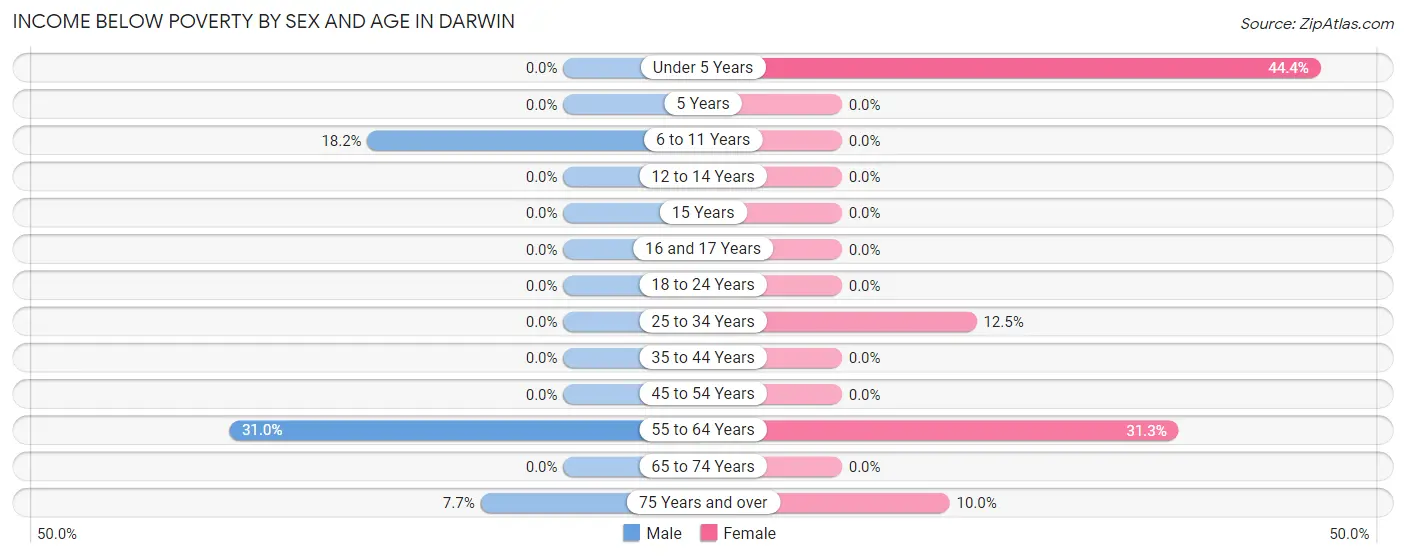
| Age Bracket | Male | Female |
| Under 5 Years | 0 (0.0%) | 4 (44.4%) |
| 5 Years | 0 (0.0%) | 0 (0.0%) |
| 6 to 11 Years | 4 (18.2%) | 0 (0.0%) |
| 12 to 14 Years | 0 (0.0%) | 0 (0.0%) |
| 15 Years | 0 (0.0%) | 0 (0.0%) |
| 16 and 17 Years | 0 (0.0%) | 0 (0.0%) |
| 18 to 24 Years | 0 (0.0%) | 0 (0.0%) |
| 25 to 34 Years | 0 (0.0%) | 2 (12.5%) |
| 35 to 44 Years | 0 (0.0%) | 0 (0.0%) |
| 45 to 54 Years | 0 (0.0%) | 0 (0.0%) |
| 55 to 64 Years | 9 (31.0%) | 5 (31.2%) |
| 65 to 74 Years | 0 (0.0%) | 0 (0.0%) |
| 75 Years and over | 1 (7.7%) | 1 (10.0%) |
| Total | 14 (6.7%) | 12 (7.1%) |
Income Above Poverty by Sex and Age in Darwin
According to the poverty statistics in Darwin, males aged under 5 years and females aged 6 to 11 years are the age groups that are most secure financially, with 100.0% of males and 100.0% of females in these age groups living above the poverty line.
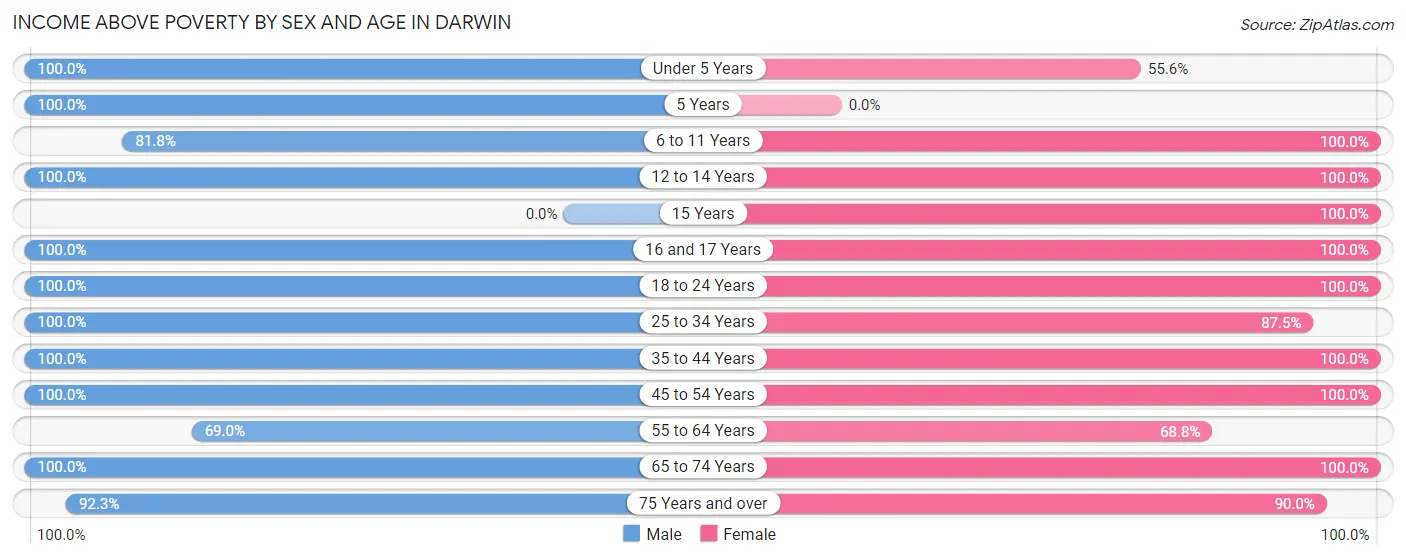
| Age Bracket | Male | Female |
| Under 5 Years | 5 (100.0%) | 5 (55.6%) |
| 5 Years | 7 (100.0%) | 0 (0.0%) |
| 6 to 11 Years | 18 (81.8%) | 21 (100.0%) |
| 12 to 14 Years | 17 (100.0%) | 4 (100.0%) |
| 15 Years | 0 (0.0%) | 6 (100.0%) |
| 16 and 17 Years | 10 (100.0%) | 5 (100.0%) |
| 18 to 24 Years | 31 (100.0%) | 20 (100.0%) |
| 25 to 34 Years | 16 (100.0%) | 14 (87.5%) |
| 35 to 44 Years | 27 (100.0%) | 23 (100.0%) |
| 45 to 54 Years | 19 (100.0%) | 18 (100.0%) |
| 55 to 64 Years | 20 (69.0%) | 11 (68.8%) |
| 65 to 74 Years | 13 (100.0%) | 20 (100.0%) |
| 75 Years and over | 12 (92.3%) | 9 (90.0%) |
| Total | 195 (93.3%) | 156 (92.9%) |
Income Below Poverty Among Married-Couple Families in Darwin
The poverty statistics for married-couple families in Darwin show that 9.5% or 6 of the total 63 families live below the poverty line. Families with no children have the highest poverty rate of 15.0%, comprising of 6 families. On the other hand, families with 1 or 2 children have the lowest poverty rate of 0.0%, which includes 0 families.

| Children | Above Poverty | Below Poverty |
| No Children | 34 (85.0%) | 6 (15.0%) |
| 1 or 2 Children | 10 (100.0%) | 0 (0.0%) |
| 3 or 4 Children | 13 (100.0%) | 0 (0.0%) |
| 5 or more Children | 0 (0.0%) | 0 (0.0%) |
| Total | 57 (90.5%) | 6 (9.5%) |
Income Below Poverty Among Single-Parent Households in Darwin

| Children | Single Father | Single Mother |
| No Children | 0 (0.0%) | 0 (0.0%) |
| 1 or 2 Children | 0 (0.0%) | 0 (0.0%) |
| 3 or 4 Children | 0 (0.0%) | 2 (100.0%) |
| 5 or more Children | 0 (0.0%) | 0 (0.0%) |
| Total | 0 (0.0%) | 2 (13.3%) |
Income Below Poverty Among Married-Couple vs Single-Parent Households in Darwin
The poverty data for Darwin shows that 6 of the married-couple family households (9.5%) and 2 of the single-parent households (10.0%) are living below the poverty level. Within the married-couple family households, those with no children have the highest poverty rate, with 6 households (15.0%) falling below the poverty line. Among the single-parent households, those with 3 or 4 children have the highest poverty rate, with 2 household (50.0%) living below poverty.

| Children | Married-Couple Families | Single-Parent Households |
| No Children | 6 (15.0%) | 0 (0.0%) |
| 1 or 2 Children | 0 (0.0%) | 0 (0.0%) |
| 3 or 4 Children | 0 (0.0%) | 2 (50.0%) |
| 5 or more Children | 0 (0.0%) | 0 (0.0%) |
| Total | 6 (9.5%) | 2 (10.0%) |
Race in Darwin
The most populous races in Darwin are White / Caucasian (354 | 93.9%), Hispanic or Latino (30 | 8.0%), and Some other Race (20 | 5.3%).

| Race | # Population | % Population |
| Asian | 0 | 0.0% |
| Black / African American | 0 | 0.0% |
| Hawaiian / Pacific | 0 | 0.0% |
| Hispanic or Latino | 30 | 8.0% |
| Native / Alaskan | 0 | 0.0% |
| White / Caucasian | 354 | 93.9% |
| Two or more Races | 3 | 0.8% |
| Some other Race | 20 | 5.3% |
| Total | 377 | 100.0% |
Ancestry in Darwin
The most populous ancestries reported in Darwin are German (135 | 35.8%), European (45 | 11.9%), Swedish (42 | 11.1%), English (29 | 7.7%), and Mexican (29 | 7.7%), together accounting for 74.3% of all Darwin residents.
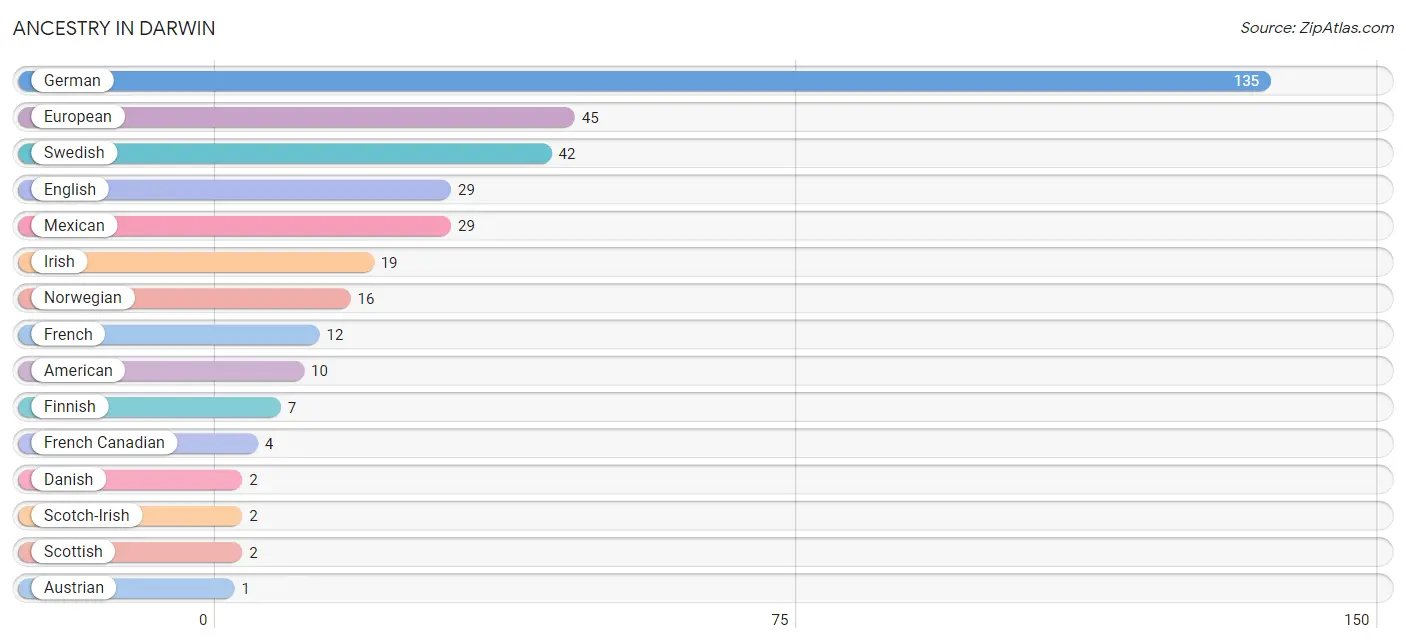
| Ancestry | # Population | % Population |
| American | 10 | 2.6% |
| Austrian | 1 | 0.3% |
| Belgian | 1 | 0.3% |
| British | 1 | 0.3% |
| Danish | 2 | 0.5% |
| English | 29 | 7.7% |
| European | 45 | 11.9% |
| Finnish | 7 | 1.9% |
| French | 12 | 3.2% |
| French Canadian | 4 | 1.1% |
| German | 135 | 35.8% |
| Greek | 1 | 0.3% |
| Irish | 19 | 5.0% |
| Mexican | 29 | 7.7% |
| Norwegian | 16 | 4.2% |
| Polish | 1 | 0.3% |
| Scotch-Irish | 2 | 0.5% |
| Scottish | 2 | 0.5% |
| Spaniard | 1 | 0.3% |
| Swedish | 42 | 11.1% |
| Welsh | 1 | 0.3% | View All 21 Rows |
Immigrants in Darwin
The most numerous immigrant groups reported in Darwin came from Central America (8 | 2.1%), Latin America (8 | 2.1%), and Mexico (8 | 2.1%), together accounting for 6.4% of all Darwin residents.

| Immigration Origin | # Population | % Population |
| Central America | 8 | 2.1% |
| Latin America | 8 | 2.1% |
| Mexico | 8 | 2.1% | View All 3 Rows |
Sex and Age in Darwin
Sex and Age in Darwin
The most populous age groups in Darwin are 10 to 14 Years (26 | 12.4%) for men and 15 to 19 Years (19 | 11.3%) for women.
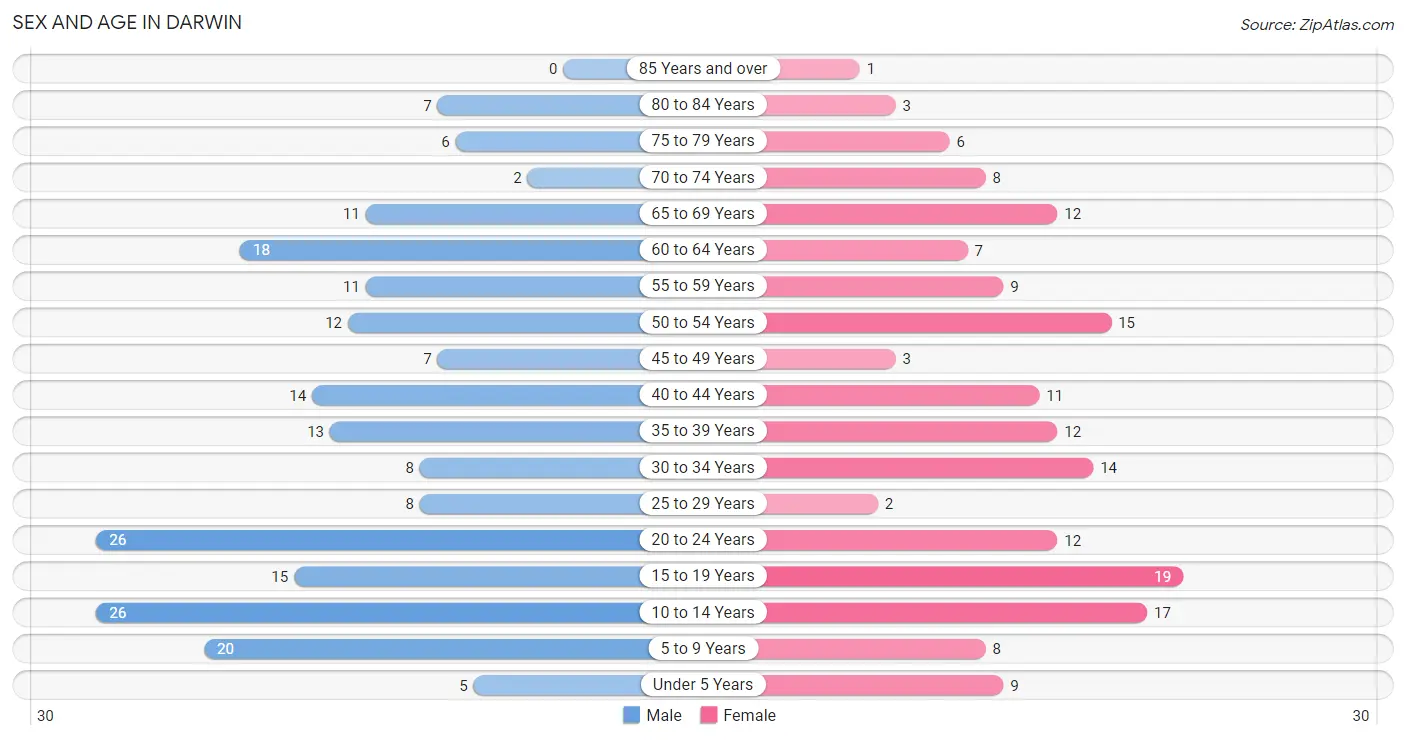
| Age Bracket | Male | Female |
| Under 5 Years | 5 (2.4%) | 9 (5.4%) |
| 5 to 9 Years | 20 (9.6%) | 8 (4.8%) |
| 10 to 14 Years | 26 (12.4%) | 17 (10.1%) |
| 15 to 19 Years | 15 (7.2%) | 19 (11.3%) |
| 20 to 24 Years | 26 (12.4%) | 12 (7.1%) |
| 25 to 29 Years | 8 (3.8%) | 2 (1.2%) |
| 30 to 34 Years | 8 (3.8%) | 14 (8.3%) |
| 35 to 39 Years | 13 (6.2%) | 12 (7.1%) |
| 40 to 44 Years | 14 (6.7%) | 11 (6.6%) |
| 45 to 49 Years | 7 (3.4%) | 3 (1.8%) |
| 50 to 54 Years | 12 (5.7%) | 15 (8.9%) |
| 55 to 59 Years | 11 (5.3%) | 9 (5.4%) |
| 60 to 64 Years | 18 (8.6%) | 7 (4.2%) |
| 65 to 69 Years | 11 (5.3%) | 12 (7.1%) |
| 70 to 74 Years | 2 (1.0%) | 8 (4.8%) |
| 75 to 79 Years | 6 (2.9%) | 6 (3.6%) |
| 80 to 84 Years | 7 (3.4%) | 3 (1.8%) |
| 85 Years and over | 0 (0.0%) | 1 (0.6%) |
| Total | 209 (100.0%) | 168 (100.0%) |
Families and Households in Darwin
Median Family Size in Darwin
The median family size in Darwin is 3.61 persons per family, with married-couple families (63 | 75.9%) accounting for the largest median family size of 3.65 persons per family. On the other hand, single male/father families (5 | 6.0%) represent the smallest median family size with 3.20 persons per family.

| Family Type | # Families | Family Size |
| Married-Couple | 63 (75.9%) | 3.65 |
| Single Male/Father | 5 (6.0%) | 3.20 |
| Single Female/Mother | 15 (18.1%) | 3.60 |
| Total Families | 83 (100.0%) | 3.61 |
Median Household Size in Darwin
The median household size in Darwin is 2.67 persons per household, with single male/father households (5 | 3.5%) accounting for the largest median household size of 4.2 persons per household. non-family households (58 | 41.1%) represent the smallest median household size with 1.16 persons per household.

| Household Type | # Households | Household Size |
| Married-Couple | 63 (44.7%) | 3.65 |
| Single Male/Father | 5 (3.5%) | 4.20 |
| Single Female/Mother | 15 (10.6%) | 3.93 |
| Non-family | 58 (41.1%) | 1.16 |
| Total Households | 141 (100.0%) | 2.67 |
Household Size by Marriage Status in Darwin
Out of a total of 141 households in Darwin, 83 (58.9%) are family households, while 58 (41.1%) are nonfamily households. The most numerous type of family households are 2-person households, comprising 34, and the most common type of nonfamily households are 1-person households, comprising 52.

| Household Size | Family Households | Nonfamily Households |
| 1-Person Households | - | 52 (36.9%) |
| 2-Person Households | 34 (24.1%) | 5 (3.5%) |
| 3-Person Households | 13 (9.2%) | 1 (0.7%) |
| 4-Person Households | 11 (7.8%) | 0 (0.0%) |
| 5-Person Households | 11 (7.8%) | 0 (0.0%) |
| 6-Person Households | 11 (7.8%) | 0 (0.0%) |
| 7+ Person Households | 3 (2.1%) | 0 (0.0%) |
| Total | 83 (58.9%) | 58 (41.1%) |
Female Fertility in Darwin
Fertility by Age in Darwin

| Age Bracket | Women with Births | Births / 1,000 Women |
| 15 to 19 years | 0 (0.0%) | 0.0 |
| 20 to 34 years | 0 (0.0%) | 0.0 |
| 35 to 50 years | 0 (0.0%) | 0.0 |
| Total | 0 (0.0%) | 0.0 |
Fertility by Age by Marriage Status in Darwin

| Age Bracket | Married | Unmarried |
| 15 to 19 years | 0 (0.0%) | 0 (0.0%) |
| 20 to 34 years | 0 (0.0%) | 0 (0.0%) |
| 35 to 50 years | 0 (0.0%) | 0 (0.0%) |
| Total | 0 (0.0%) | 0 (0.0%) |
Fertility by Education in Darwin
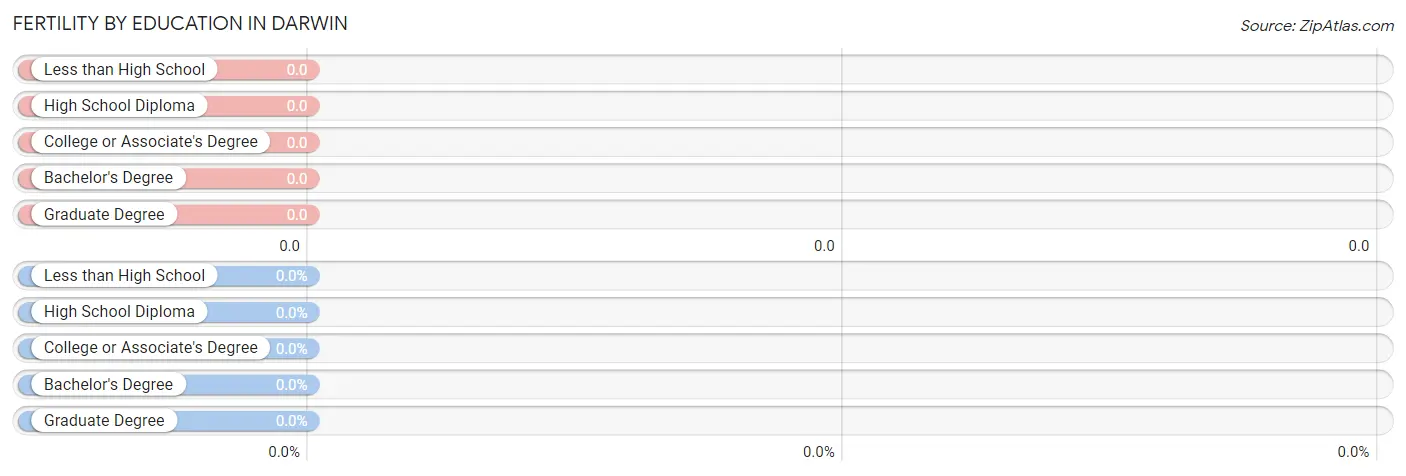
| Educational Attainment | Women with Births | Births / 1,000 Women |
| Less than High School | 0 (0.0%) | 0.0 |
| High School Diploma | 0 (0.0%) | 0.0 |
| College or Associate's Degree | 0 (0.0%) | 0.0 |
| Bachelor's Degree | 0 (0.0%) | 0.0 |
| Graduate Degree | 0 (0.0%) | 0.0 |
| Total | 0 (0.0%) | 0.0 |
Fertility by Education by Marriage Status in Darwin

| Educational Attainment | Married | Unmarried |
| Less than High School | 0 (0.0%) | 0 (0.0%) |
| High School Diploma | 0 (0.0%) | 0 (0.0%) |
| College or Associate's Degree | 0 (0.0%) | 0 (0.0%) |
| Bachelor's Degree | 0 (0.0%) | 0 (0.0%) |
| Graduate Degree | 0 (0.0%) | 0 (0.0%) |
| Total | 0 (0.0%) | 0 (0.0%) |
Employment Characteristics in Darwin
Employment by Class of Employer in Darwin
Among the 183 employed individuals in Darwin, private company employees (135 | 73.8%), not-for-profit organizations (15 | 8.2%), and local government employees (14 | 7.6%) make up the most common classes of employment.

| Employer Class | # Employees | % Employees |
| Private Company Employees | 135 | 73.8% |
| Self-Employed (Incorporated) | 8 | 4.4% |
| Self-Employed (Not Incorporated) | 4 | 2.2% |
| Not-for-profit Organizations | 15 | 8.2% |
| Local Government Employees | 14 | 7.6% |
| State Government Employees | 2 | 1.1% |
| Federal Government Employees | 5 | 2.7% |
| Unpaid Family Workers | 0 | 0.0% |
| Total | 183 | 100.0% |
Employment Status by Age in Darwin
According to the labor force statistics for Darwin, out of the total population over 16 years of age (286), 69.9% or 200 individuals are in the labor force, with 6.5% or 13 of them unemployed. The age group with the highest labor force participation rate is 20 to 24 years, with 100.0% or 38 individuals in the labor force. Within the labor force, the 16 to 19 years age range has the highest percentage of unemployed individuals, with 23.1% or 3 of them being unemployed.

| Age Bracket | In Labor Force | Unemployed |
| 16 to 19 Years | 13 (46.4%) | 3 (23.1%) |
| 20 to 24 Years | 38 (100.0%) | 7 (18.4%) |
| 25 to 29 Years | 8 (80.0%) | 0 (0.0%) |
| 30 to 34 Years | 22 (100.0%) | 0 (0.0%) |
| 35 to 44 Years | 50 (100.0%) | 2 (4.0%) |
| 45 to 54 Years | 36 (97.3%) | 1 (2.8%) |
| 55 to 59 Years | 14 (70.0%) | 0 (0.0%) |
| 60 to 64 Years | 10 (40.0%) | 0 (0.0%) |
| 65 to 74 Years | 8 (24.2%) | 0 (0.0%) |
| 75 Years and over | 1 (4.3%) | 0 (0.0%) |
| Total | 200 (69.9%) | 13 (6.5%) |
Employment Status by Educational Attainment in Darwin
According to labor force statistics for Darwin, 85.4% of individuals (140) out of the total population between 25 and 64 years of age (164) are in the labor force, with 2.1% or 3 of them being unemployed. The group with the highest labor force participation rate are those with the educational attainment of bachelor's degree or higher, with 100.0% or 39 individuals in the labor force. Within the labor force, individuals with bachelor's degree or higher education have the highest percentage of unemployment, with 5.1% or 2 of them being unemployed.

| Educational Attainment | In Labor Force | Unemployed |
| Less than High School | 11 (84.6%) | 0 (0.0%) |
| High School Diploma | 40 (76.9%) | 1 (2.5%) |
| College / Associate Degree | 50 (83.3%) | 0 (0.0%) |
| Bachelor's Degree or higher | 39 (100.0%) | 2 (5.1%) |
| Total | 140 (85.4%) | 3 (2.1%) |
Employment Occupations by Sex in Darwin
Management, Business, Science and Arts Occupations
The most common Management, Business, Science and Arts occupations in Darwin are Business & Financial (18 | 9.6%), Management (15 | 8.0%), Community & Social Service (15 | 8.0%), Health Diagnosing & Treating (11 | 5.9%), and Computers, Engineering & Science (10 | 5.3%).
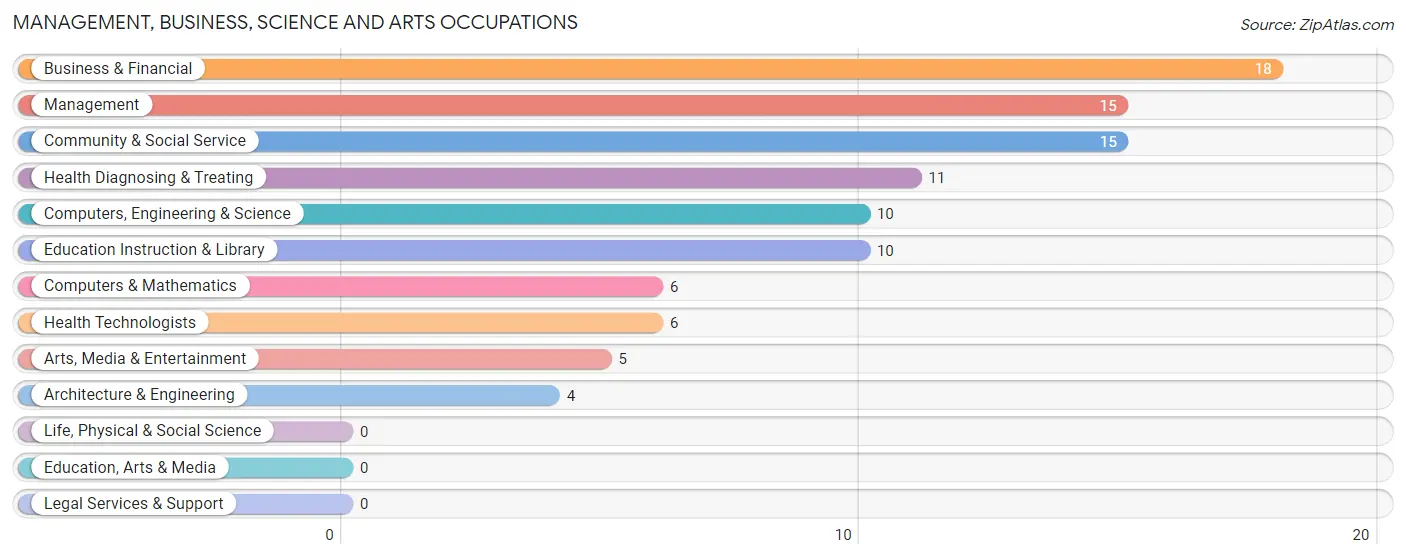
Management, Business, Science and Arts Occupations by Sex
Within the Management, Business, Science and Arts occupations in Darwin, the most male-oriented occupations are Computers, Engineering & Science (100.0%), Computers & Mathematics (100.0%), and Architecture & Engineering (100.0%), while the most female-oriented occupations are Health Diagnosing & Treating (100.0%), Health Technologists (100.0%), and Education Instruction & Library (90.0%).
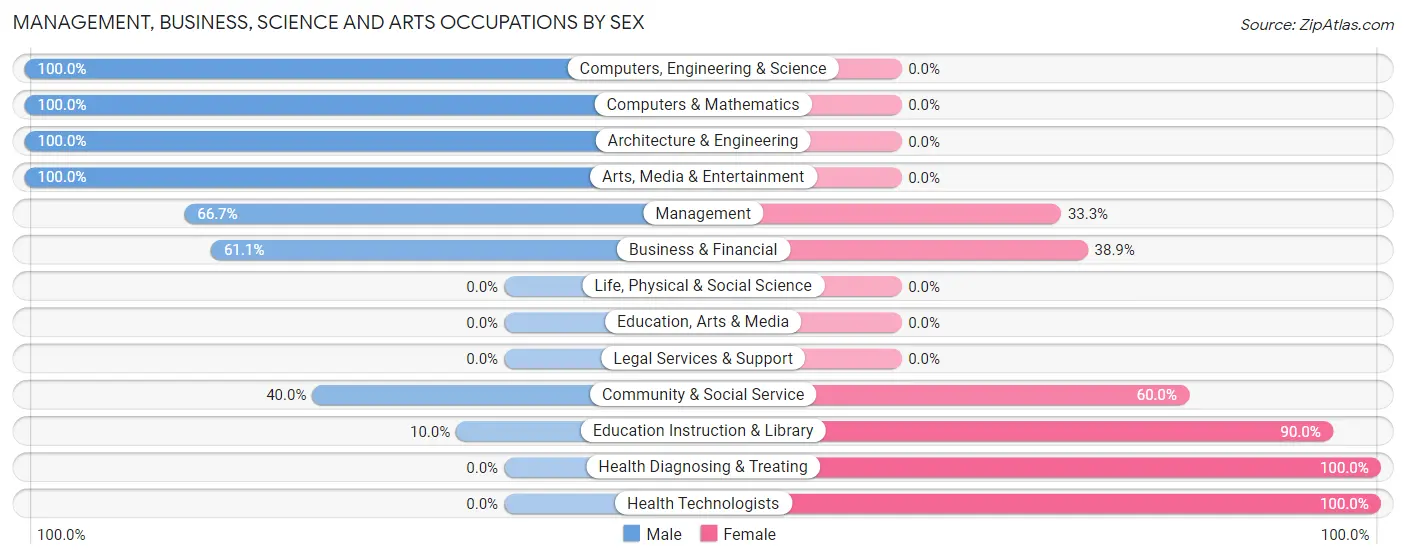
| Occupation | Male | Female |
| Management | 10 (66.7%) | 5 (33.3%) |
| Business & Financial | 11 (61.1%) | 7 (38.9%) |
| Computers, Engineering & Science | 10 (100.0%) | 0 (0.0%) |
| Computers & Mathematics | 6 (100.0%) | 0 (0.0%) |
| Architecture & Engineering | 4 (100.0%) | 0 (0.0%) |
| Life, Physical & Social Science | 0 (0.0%) | 0 (0.0%) |
| Community & Social Service | 6 (40.0%) | 9 (60.0%) |
| Education, Arts & Media | 0 (0.0%) | 0 (0.0%) |
| Legal Services & Support | 0 (0.0%) | 0 (0.0%) |
| Education Instruction & Library | 1 (10.0%) | 9 (90.0%) |
| Arts, Media & Entertainment | 5 (100.0%) | 0 (0.0%) |
| Health Diagnosing & Treating | 0 (0.0%) | 11 (100.0%) |
| Health Technologists | 0 (0.0%) | 6 (100.0%) |
| Total (Category) | 37 (53.6%) | 32 (46.4%) |
| Total (Overall) | 104 (55.6%) | 83 (44.4%) |
Services Occupations
The most common Services occupations in Darwin are Food Preparation & Serving (6 | 3.2%), Healthcare Support (5 | 2.7%), Personal Care & Service (3 | 1.6%), Security & Protection (2 | 1.1%), and Law Enforcement (2 | 1.1%).

Services Occupations by Sex
Within the Services occupations in Darwin, the most male-oriented occupations are Security & Protection (100.0%), Law Enforcement (100.0%), and Cleaning & Maintenance (100.0%), while the most female-oriented occupations are Healthcare Support (80.0%), Food Preparation & Serving (66.7%), and Personal Care & Service (66.7%).

| Occupation | Male | Female |
| Healthcare Support | 1 (20.0%) | 4 (80.0%) |
| Security & Protection | 2 (100.0%) | 0 (0.0%) |
| Firefighting & Prevention | 0 (0.0%) | 0 (0.0%) |
| Law Enforcement | 2 (100.0%) | 0 (0.0%) |
| Food Preparation & Serving | 2 (33.3%) | 4 (66.7%) |
| Cleaning & Maintenance | 2 (100.0%) | 0 (0.0%) |
| Personal Care & Service | 1 (33.3%) | 2 (66.7%) |
| Total (Category) | 8 (44.4%) | 10 (55.6%) |
| Total (Overall) | 104 (55.6%) | 83 (44.4%) |
Sales and Office Occupations
The most common Sales and Office occupations in Darwin are Office & Administration (18 | 9.6%), and Sales & Related (10 | 5.3%).

Sales and Office Occupations by Sex

| Occupation | Male | Female |
| Sales & Related | 1 (10.0%) | 9 (90.0%) |
| Office & Administration | 6 (33.3%) | 12 (66.7%) |
| Total (Category) | 7 (25.0%) | 21 (75.0%) |
| Total (Overall) | 104 (55.6%) | 83 (44.4%) |
Natural Resources, Construction and Maintenance Occupations
The most common Natural Resources, Construction and Maintenance occupations in Darwin are Construction & Extraction (11 | 5.9%), and Installation, Maintenance & Repair (3 | 1.6%).

Natural Resources, Construction and Maintenance Occupations by Sex

| Occupation | Male | Female |
| Farming, Fishing & Forestry | 0 (0.0%) | 0 (0.0%) |
| Construction & Extraction | 11 (100.0%) | 0 (0.0%) |
| Installation, Maintenance & Repair | 3 (100.0%) | 0 (0.0%) |
| Total (Category) | 14 (100.0%) | 0 (0.0%) |
| Total (Overall) | 104 (55.6%) | 83 (44.4%) |
Production, Transportation and Moving Occupations
The most common Production, Transportation and Moving occupations in Darwin are Production (35 | 18.7%), Material Moving (19 | 10.2%), and Transportation (4 | 2.1%).

Production, Transportation and Moving Occupations by Sex

| Occupation | Male | Female |
| Production | 25 (71.4%) | 10 (28.6%) |
| Transportation | 4 (100.0%) | 0 (0.0%) |
| Material Moving | 9 (47.4%) | 10 (52.6%) |
| Total (Category) | 38 (65.5%) | 20 (34.5%) |
| Total (Overall) | 104 (55.6%) | 83 (44.4%) |
Employment Industries by Sex in Darwin
Employment Industries in Darwin
The major employment industries in Darwin include Manufacturing (67 | 35.8%), Construction (30 | 16.0%), Retail Trade (23 | 12.3%), Health Care & Social Assistance (13 | 7.0%), and Educational Services (10 | 5.3%).
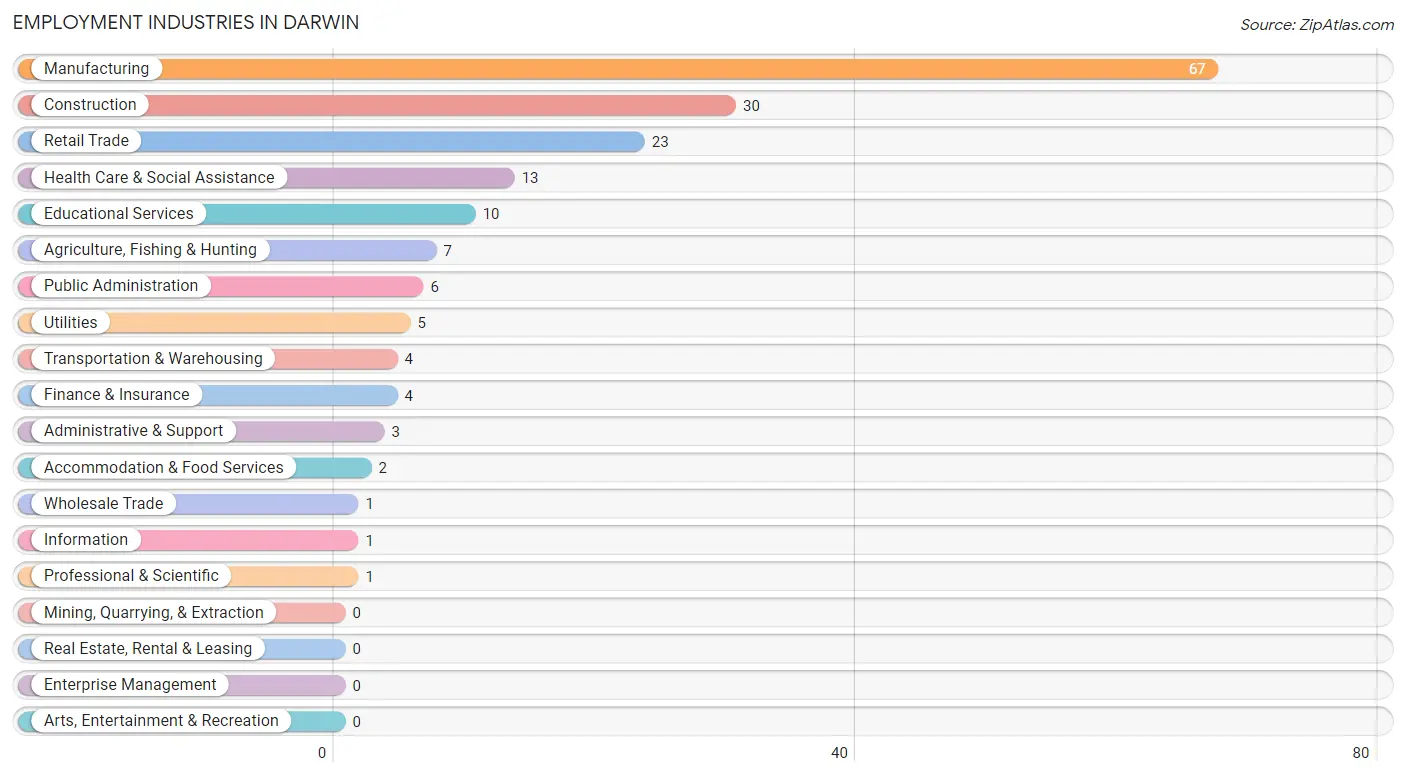
Employment Industries by Sex in Darwin
The Darwin industries that see more men than women are Transportation & Warehousing (100.0%), Utilities (100.0%), and Professional & Scientific (100.0%), whereas the industries that tend to have a higher number of women are Wholesale Trade (100.0%), Information (100.0%), and Finance & Insurance (100.0%).
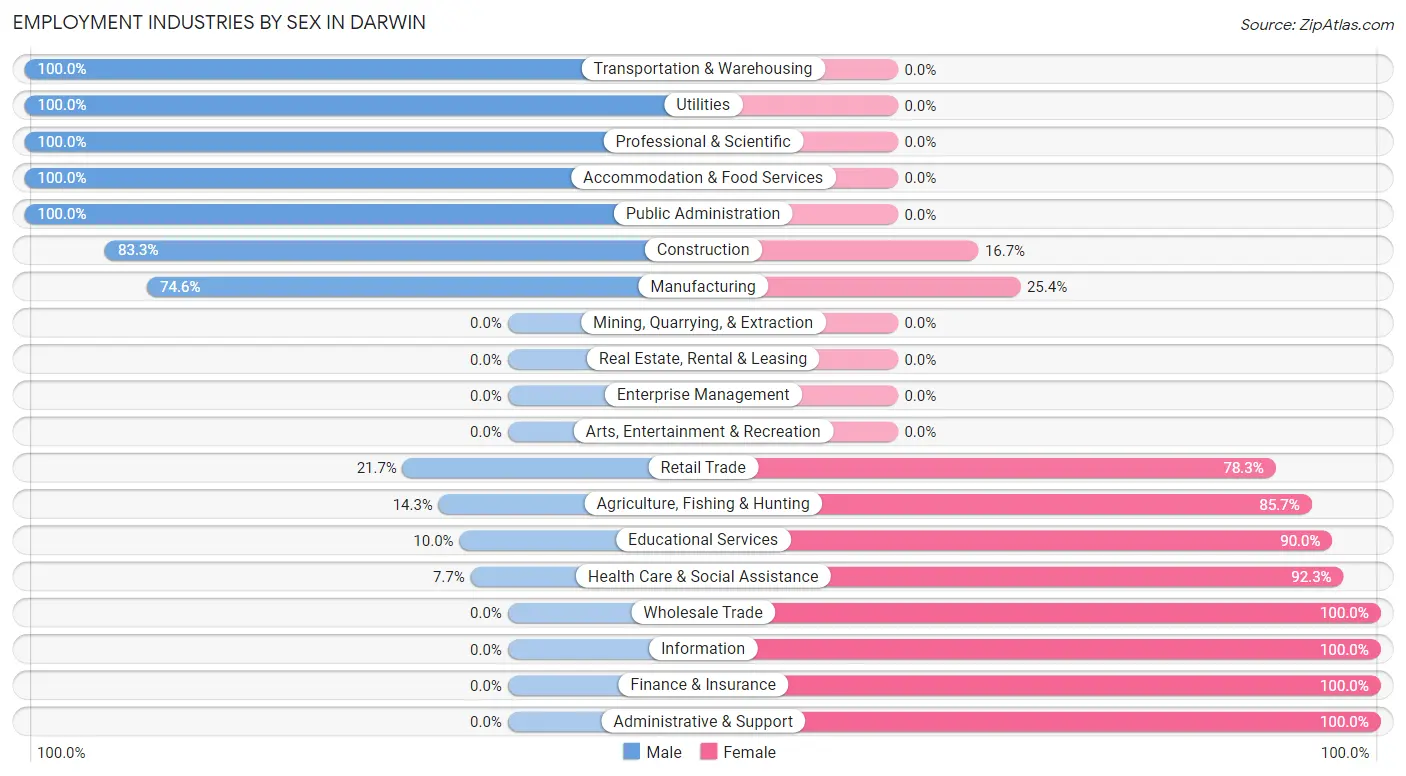
| Industry | Male | Female |
| Agriculture, Fishing & Hunting | 1 (14.3%) | 6 (85.7%) |
| Mining, Quarrying, & Extraction | 0 (0.0%) | 0 (0.0%) |
| Construction | 25 (83.3%) | 5 (16.7%) |
| Manufacturing | 50 (74.6%) | 17 (25.4%) |
| Wholesale Trade | 0 (0.0%) | 1 (100.0%) |
| Retail Trade | 5 (21.7%) | 18 (78.3%) |
| Transportation & Warehousing | 4 (100.0%) | 0 (0.0%) |
| Utilities | 5 (100.0%) | 0 (0.0%) |
| Information | 0 (0.0%) | 1 (100.0%) |
| Finance & Insurance | 0 (0.0%) | 4 (100.0%) |
| Real Estate, Rental & Leasing | 0 (0.0%) | 0 (0.0%) |
| Professional & Scientific | 1 (100.0%) | 0 (0.0%) |
| Enterprise Management | 0 (0.0%) | 0 (0.0%) |
| Administrative & Support | 0 (0.0%) | 3 (100.0%) |
| Educational Services | 1 (10.0%) | 9 (90.0%) |
| Health Care & Social Assistance | 1 (7.7%) | 12 (92.3%) |
| Arts, Entertainment & Recreation | 0 (0.0%) | 0 (0.0%) |
| Accommodation & Food Services | 2 (100.0%) | 0 (0.0%) |
| Public Administration | 6 (100.0%) | 0 (0.0%) |
| Total | 104 (55.6%) | 83 (44.4%) |
Education in Darwin
School Enrollment in Darwin
The most common levels of schooling among the 118 students in Darwin are high school (41 | 34.7%), middle school (28 | 23.7%), and elementary school (20 | 17.0%).

| School Level | # Students | % Students |
| Nursery / Preschool | 7 | 5.9% |
| Kindergarten | 6 | 5.1% |
| Elementary School | 20 | 17.0% |
| Middle School | 28 | 23.7% |
| High School | 41 | 34.7% |
| College / Undergraduate | 14 | 11.9% |
| Graduate / Professional | 2 | 1.7% |
| Total | 118 | 100.0% |
School Enrollment by Age by Funding Source in Darwin
Out of a total of 118 students who are enrolled in schools in Darwin, 14 (11.9%) attend a private institution, while the remaining 104 (88.1%) are enrolled in public schools. The age group of 3 to 4 year olds has the highest likelihood of being enrolled in private schools, with 5 (83.3% in the age bracket) enrolled. Conversely, the age group of 10 to 14 year olds has the lowest likelihood of being enrolled in a private school, with 43 (100.0% in the age bracket) attending a public institution.

| Age Bracket | Public School | Private School |
| 3 to 4 Year Olds | 1 (16.7%) | 5 (83.3%) |
| 5 to 9 Year Old | 17 (65.4%) | 9 (34.6%) |
| 10 to 14 Year Olds | 43 (100.0%) | 0 (0.0%) |
| 15 to 17 Year Olds | 21 (100.0%) | 0 (0.0%) |
| 18 to 19 Year Olds | 10 (100.0%) | 0 (0.0%) |
| 20 to 24 Year Olds | 8 (100.0%) | 0 (0.0%) |
| 25 to 34 Year Olds | 0 (0.0%) | 0 (0.0%) |
| 35 Years and over | 4 (100.0%) | 0 (0.0%) |
| Total | 104 (88.1%) | 14 (11.9%) |
Educational Attainment by Field of Study in Darwin
Education (11 | 26.2%), business (9 | 21.4%), science & technology (8 | 19.1%), bio, nature & agricultural (7 | 16.7%), and arts & humanities (3 | 7.1%) are the most common fields of study among 42 individuals in Darwin who have obtained a bachelor's degree or higher.
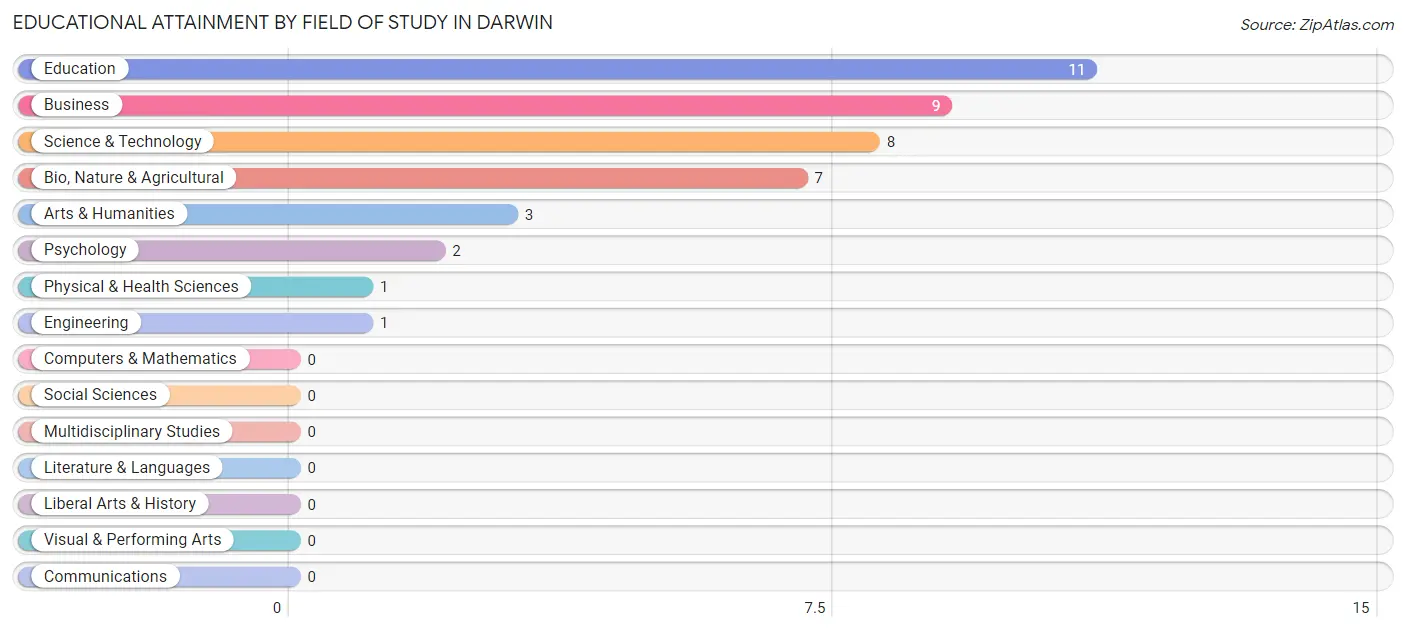
| Field of Study | # Graduates | % Graduates |
| Computers & Mathematics | 0 | 0.0% |
| Bio, Nature & Agricultural | 7 | 16.7% |
| Physical & Health Sciences | 1 | 2.4% |
| Psychology | 2 | 4.8% |
| Social Sciences | 0 | 0.0% |
| Engineering | 1 | 2.4% |
| Multidisciplinary Studies | 0 | 0.0% |
| Science & Technology | 8 | 19.1% |
| Business | 9 | 21.4% |
| Education | 11 | 26.2% |
| Literature & Languages | 0 | 0.0% |
| Liberal Arts & History | 0 | 0.0% |
| Visual & Performing Arts | 0 | 0.0% |
| Communications | 0 | 0.0% |
| Arts & Humanities | 3 | 7.1% |
| Total | 42 | 100.0% |
Transportation & Commute in Darwin
Vehicle Availability by Sex in Darwin
The most prevalent vehicle ownership categories in Darwin are males with 2 vehicles (36, accounting for 36.0%) and females with 2 vehicles (28, making up 43.4%).

| Vehicles Available | Male | Female |
| No Vehicle | 0 (0.0%) | 0 (0.0%) |
| 1 Vehicle | 6 (6.0%) | 5 (6.0%) |
| 2 Vehicles | 36 (36.0%) | 28 (33.7%) |
| 3 Vehicles | 28 (28.0%) | 22 (26.5%) |
| 4 Vehicles | 10 (10.0%) | 13 (15.7%) |
| 5 or more Vehicles | 20 (20.0%) | 15 (18.1%) |
| Total | 100 (100.0%) | 83 (100.0%) |
Commute Time in Darwin
The most frequently occuring commute durations in Darwin are 15 to 19 minutes (28 commuters, 15.6%), 5 to 9 minutes (26 commuters, 14.5%), and 10 to 14 minutes (25 commuters, 14.0%).
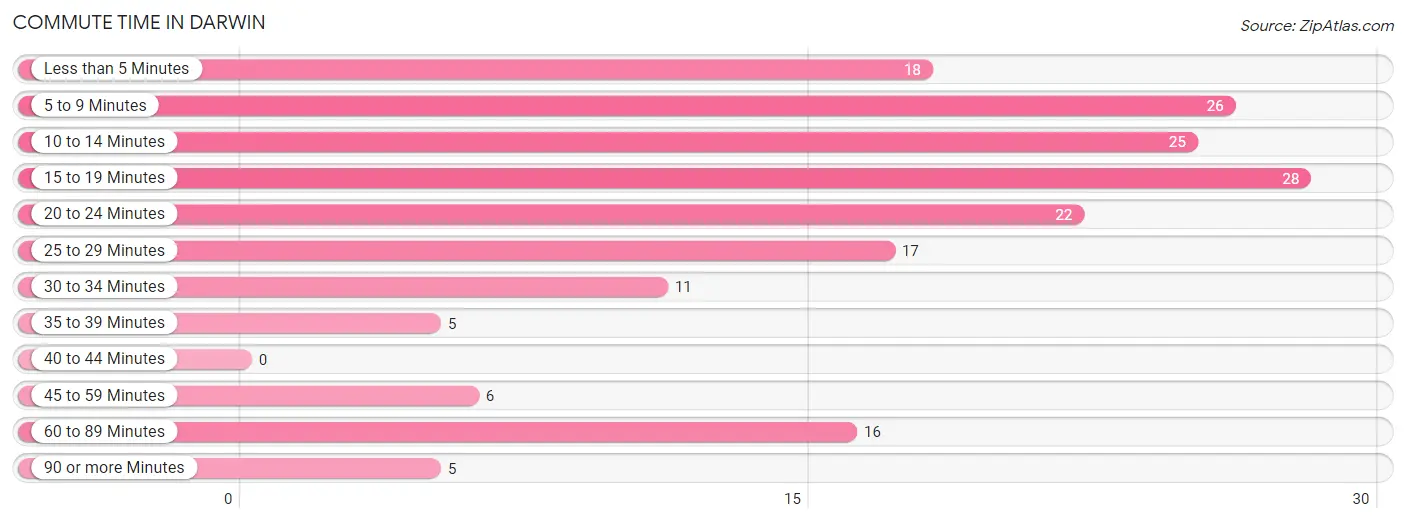
| Commute Time | # Commuters | % Commuters |
| Less than 5 Minutes | 18 | 10.1% |
| 5 to 9 Minutes | 26 | 14.5% |
| 10 to 14 Minutes | 25 | 14.0% |
| 15 to 19 Minutes | 28 | 15.6% |
| 20 to 24 Minutes | 22 | 12.3% |
| 25 to 29 Minutes | 17 | 9.5% |
| 30 to 34 Minutes | 11 | 6.1% |
| 35 to 39 Minutes | 5 | 2.8% |
| 40 to 44 Minutes | 0 | 0.0% |
| 45 to 59 Minutes | 6 | 3.4% |
| 60 to 89 Minutes | 16 | 8.9% |
| 90 or more Minutes | 5 | 2.8% |
Commute Time by Sex in Darwin
The most common commute times in Darwin are less than 5 minutes (14 commuters, 14.3%) for males and 15 to 19 minutes (20 commuters, 24.7%) for females.
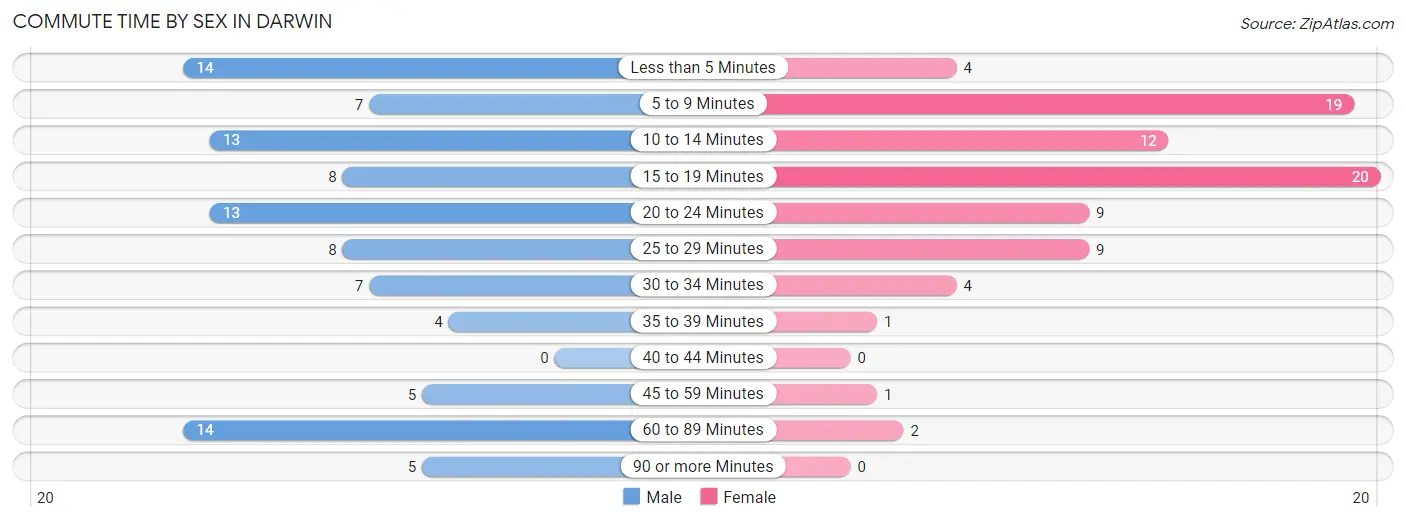
| Commute Time | Male | Female |
| Less than 5 Minutes | 14 (14.3%) | 4 (4.9%) |
| 5 to 9 Minutes | 7 (7.1%) | 19 (23.5%) |
| 10 to 14 Minutes | 13 (13.3%) | 12 (14.8%) |
| 15 to 19 Minutes | 8 (8.2%) | 20 (24.7%) |
| 20 to 24 Minutes | 13 (13.3%) | 9 (11.1%) |
| 25 to 29 Minutes | 8 (8.2%) | 9 (11.1%) |
| 30 to 34 Minutes | 7 (7.1%) | 4 (4.9%) |
| 35 to 39 Minutes | 4 (4.1%) | 1 (1.2%) |
| 40 to 44 Minutes | 0 (0.0%) | 0 (0.0%) |
| 45 to 59 Minutes | 5 (5.1%) | 1 (1.2%) |
| 60 to 89 Minutes | 14 (14.3%) | 2 (2.5%) |
| 90 or more Minutes | 5 (5.1%) | 0 (0.0%) |
Time of Departure to Work by Sex in Darwin
The most frequent times of departure to work in Darwin are 12:00 AM to 4:59 AM (20, 20.4%) for males and 7:30 AM to 7:59 AM (19, 23.5%) for females.
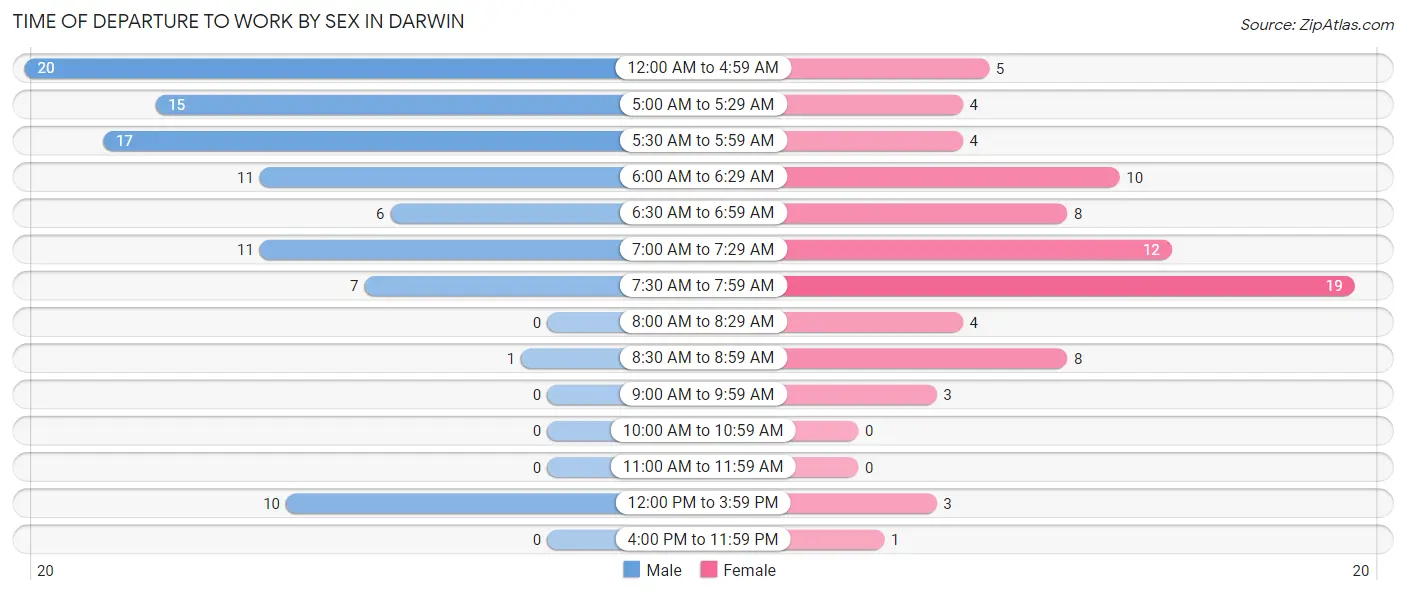
| Time of Departure | Male | Female |
| 12:00 AM to 4:59 AM | 20 (20.4%) | 5 (6.2%) |
| 5:00 AM to 5:29 AM | 15 (15.3%) | 4 (4.9%) |
| 5:30 AM to 5:59 AM | 17 (17.3%) | 4 (4.9%) |
| 6:00 AM to 6:29 AM | 11 (11.2%) | 10 (12.3%) |
| 6:30 AM to 6:59 AM | 6 (6.1%) | 8 (9.9%) |
| 7:00 AM to 7:29 AM | 11 (11.2%) | 12 (14.8%) |
| 7:30 AM to 7:59 AM | 7 (7.1%) | 19 (23.5%) |
| 8:00 AM to 8:29 AM | 0 (0.0%) | 4 (4.9%) |
| 8:30 AM to 8:59 AM | 1 (1.0%) | 8 (9.9%) |
| 9:00 AM to 9:59 AM | 0 (0.0%) | 3 (3.7%) |
| 10:00 AM to 10:59 AM | 0 (0.0%) | 0 (0.0%) |
| 11:00 AM to 11:59 AM | 0 (0.0%) | 0 (0.0%) |
| 12:00 PM to 3:59 PM | 10 (10.2%) | 3 (3.7%) |
| 4:00 PM to 11:59 PM | 0 (0.0%) | 1 (1.2%) |
| Total | 98 (100.0%) | 81 (100.0%) |
Housing Occupancy in Darwin
Occupancy by Ownership in Darwin
Of the total 141 dwellings in Darwin, owner-occupied units account for 124 (87.9%), while renter-occupied units make up 17 (12.1%).

| Occupancy | # Housing Units | % Housing Units |
| Owner Occupied Housing Units | 124 | 87.9% |
| Renter-Occupied Housing Units | 17 | 12.1% |
| Total Occupied Housing Units | 141 | 100.0% |
Occupancy by Household Size in Darwin

| Household Size | # Housing Units | % Housing Units |
| 1-Person Household | 52 | 36.9% |
| 2-Person Household | 39 | 27.7% |
| 3-Person Household | 14 | 9.9% |
| 4+ Person Household | 36 | 25.5% |
| Total Housing Units | 141 | 100.0% |
Occupancy by Ownership by Household Size in Darwin

| Household Size | Owner-occupied | Renter-occupied |
| 1-Person Household | 41 (78.8%) | 11 (21.1%) |
| 2-Person Household | 36 (92.3%) | 3 (7.7%) |
| 3-Person Household | 14 (100.0%) | 0 (0.0%) |
| 4+ Person Household | 33 (91.7%) | 3 (8.3%) |
| Total Housing Units | 124 (87.9%) | 17 (12.1%) |
Occupancy by Educational Attainment in Darwin

| Household Size | Owner-occupied | Renter-occupied |
| Less than High School | 8 (100.0%) | 0 (0.0%) |
| High School Diploma | 51 (87.9%) | 7 (12.1%) |
| College/Associate Degree | 37 (82.2%) | 8 (17.8%) |
| Bachelor's Degree or higher | 28 (93.3%) | 2 (6.7%) |
Occupancy by Age of Householder in Darwin

| Age Bracket | # Households | % Households |
| Under 35 Years | 30 | 21.3% |
| 35 to 44 Years | 27 | 19.2% |
| 45 to 54 Years | 20 | 14.2% |
| 55 to 64 Years | 22 | 15.6% |
| 65 to 74 Years | 25 | 17.7% |
| 75 to 84 Years | 16 | 11.4% |
| 85 Years and Over | 1 | 0.7% |
| Total | 141 | 100.0% |
Housing Finances in Darwin
Median Income by Occupancy in Darwin

| Occupancy Type | # Households | Median Income |
| Owner-Occupied | 124 (87.9%) | $62,222 |
| Renter-Occupied | 17 (12.1%) | $0 |
| Average | 141 (100.0%) | $62,083 |
Occupancy by Householder Income Bracket in Darwin
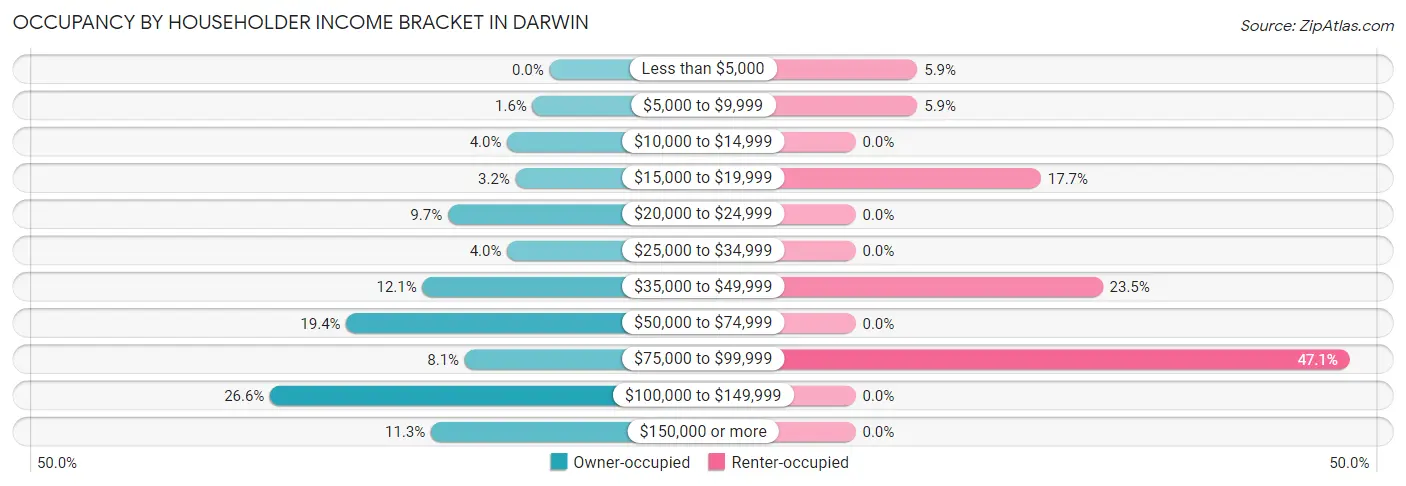
| Income Bracket | Owner-occupied | Renter-occupied |
| Less than $5,000 | 0 (0.0%) | 1 (5.9%) |
| $5,000 to $9,999 | 2 (1.6%) | 1 (5.9%) |
| $10,000 to $14,999 | 5 (4.0%) | 0 (0.0%) |
| $15,000 to $19,999 | 4 (3.2%) | 3 (17.6%) |
| $20,000 to $24,999 | 12 (9.7%) | 0 (0.0%) |
| $25,000 to $34,999 | 5 (4.0%) | 0 (0.0%) |
| $35,000 to $49,999 | 15 (12.1%) | 4 (23.5%) |
| $50,000 to $74,999 | 24 (19.4%) | 0 (0.0%) |
| $75,000 to $99,999 | 10 (8.1%) | 8 (47.1%) |
| $100,000 to $149,999 | 33 (26.6%) | 0 (0.0%) |
| $150,000 or more | 14 (11.3%) | 0 (0.0%) |
| Total | 124 (100.0%) | 17 (100.0%) |
Monthly Housing Cost Tiers in Darwin

| Monthly Cost | Owner-occupied | Renter-occupied |
| Less than $300 | 11 (8.9%) | 1 (5.9%) |
| $300 to $499 | 17 (13.7%) | 1 (5.9%) |
| $500 to $799 | 20 (16.1%) | 3 (17.6%) |
| $800 to $999 | 17 (13.7%) | 0 (0.0%) |
| $1,000 to $1,499 | 24 (19.4%) | 7 (41.2%) |
| $1,500 to $1,999 | 20 (16.1%) | 0 (0.0%) |
| $2,000 to $2,499 | 9 (7.3%) | 0 (0.0%) |
| $2,500 to $2,999 | 0 (0.0%) | 0 (0.0%) |
| $3,000 or more | 6 (4.8%) | 0 (0.0%) |
| Total | 124 (100.0%) | 17 (100.0%) |
Physical Housing Characteristics in Darwin
Housing Structures in Darwin

| Structure Type | # Housing Units | % Housing Units |
| Single Unit, Detached | 115 | 81.6% |
| Single Unit, Attached | 2 | 1.4% |
| 2 Unit Apartments | 7 | 5.0% |
| 3 or 4 Unit Apartments | 0 | 0.0% |
| 5 to 9 Unit Apartments | 4 | 2.8% |
| 10 or more Apartments | 0 | 0.0% |
| Mobile Home / Other | 13 | 9.2% |
| Total | 141 | 100.0% |
Housing Structures by Occupancy in Darwin

| Structure Type | Owner-occupied | Renter-occupied |
| Single Unit, Detached | 109 (94.8%) | 6 (5.2%) |
| Single Unit, Attached | 2 (100.0%) | 0 (0.0%) |
| 2 Unit Apartments | 0 (0.0%) | 7 (100.0%) |
| 3 or 4 Unit Apartments | 0 (0.0%) | 0 (0.0%) |
| 5 to 9 Unit Apartments | 0 (0.0%) | 4 (100.0%) |
| 10 or more Apartments | 0 (0.0%) | 0 (0.0%) |
| Mobile Home / Other | 13 (100.0%) | 0 (0.0%) |
| Total | 124 (87.9%) | 17 (12.1%) |
Housing Structures by Number of Rooms in Darwin

| Number of Rooms | Owner-occupied | Renter-occupied |
| 1 Room | 2 (1.6%) | 0 (0.0%) |
| 2 or 3 Rooms | 5 (4.0%) | 6 (35.3%) |
| 4 or 5 Rooms | 49 (39.5%) | 6 (35.3%) |
| 6 or 7 Rooms | 41 (33.1%) | 3 (17.6%) |
| 8 or more Rooms | 27 (21.8%) | 2 (11.8%) |
| Total | 124 (100.0%) | 17 (100.0%) |
Housing Structure by Heating Type in Darwin

| Heating Type | Owner-occupied | Renter-occupied |
| Utility Gas | 76 (61.3%) | 2 (11.8%) |
| Bottled, Tank, or LP Gas | 36 (29.0%) | 4 (23.5%) |
| Electricity | 9 (7.3%) | 7 (41.2%) |
| Fuel Oil or Kerosene | 0 (0.0%) | 0 (0.0%) |
| Coal or Coke | 0 (0.0%) | 0 (0.0%) |
| All other Fuels | 1 (0.8%) | 4 (23.5%) |
| No Fuel Used | 2 (1.6%) | 0 (0.0%) |
| Total | 124 (100.0%) | 17 (100.0%) |
Household Vehicle Usage in Darwin

| Vehicles per Household | Owner-occupied | Renter-occupied |
| No Vehicle | 5 (4.0%) | 3 (17.6%) |
| 1 Vehicle | 25 (20.2%) | 5 (29.4%) |
| 2 Vehicles | 53 (42.7%) | 6 (35.3%) |
| 3 or more Vehicles | 41 (33.1%) | 3 (17.6%) |
| Total | 124 (100.0%) | 17 (100.0%) |
Real Estate & Mortgages in Darwin
Real Estate and Mortgage Overview in Darwin
| Characteristic | Without Mortgage | With Mortgage |
| Housing Units | 48 | 76 |
| Median Property Value | $125,000 | $205,600 |
| Median Household Income | $49,167 | $10 |
| Monthly Housing Costs | $400 | $6 |
| Real Estate Taxes | $1,118 | $0 |
Property Value by Mortgage Status in Darwin

| Property Value | Without Mortgage | With Mortgage |
| Less than $50,000 | 11 (22.9%) | 1 (1.3%) |
| $50,000 to $99,999 | 7 (14.6%) | 9 (11.8%) |
| $100,000 to $299,999 | 24 (50.0%) | 45 (59.2%) |
| $300,000 to $499,999 | 6 (12.5%) | 16 (21.0%) |
| $500,000 to $749,999 | 0 (0.0%) | 3 (4.0%) |
| $750,000 to $999,999 | 0 (0.0%) | 0 (0.0%) |
| $1,000,000 or more | 0 (0.0%) | 2 (2.6%) |
| Total | 48 (100.0%) | 76 (100.0%) |
Household Income by Mortgage Status in Darwin

| Household Income | Without Mortgage | With Mortgage |
| Less than $10,000 | 0 (0.0%) | 0 (0.0%) |
| $10,000 to $24,999 | 13 (27.1%) | 2 (2.6%) |
| $25,000 to $34,999 | 3 (6.2%) | 8 (10.5%) |
| $35,000 to $49,999 | 9 (18.8%) | 2 (2.6%) |
| $50,000 to $74,999 | 12 (25.0%) | 6 (7.9%) |
| $75,000 to $99,999 | 4 (8.3%) | 12 (15.8%) |
| $100,000 to $149,999 | 3 (6.2%) | 6 (7.9%) |
| $150,000 or more | 4 (8.3%) | 30 (39.5%) |
| Total | 48 (100.0%) | 76 (100.0%) |
Property Value to Household Income Ratio in Darwin

| Value-to-Income Ratio | Without Mortgage | With Mortgage |
| Less than 2.0x | 22 (45.8%) | 105,000 (138,157.9%) |
| 2.0x to 2.9x | 12 (25.0%) | 26 (34.2%) |
| 3.0x to 3.9x | 7 (14.6%) | 27 (35.5%) |
| 4.0x or more | 7 (14.6%) | 9 (11.8%) |
| Total | 48 (100.0%) | 76 (100.0%) |
Real Estate Taxes by Mortgage Status in Darwin

| Property Taxes | Without Mortgage | With Mortgage |
| Less than $800 | 16 (33.3%) | 0 (0.0%) |
| $800 to $1,499 | 20 (41.7%) | 12 (15.8%) |
| $800 to $1,499 | 10 (20.8%) | 24 (31.6%) |
| Total | 48 (100.0%) | 76 (100.0%) |
Health & Disability in Darwin
Health Insurance Coverage by Age in Darwin

| Age Bracket | With Coverage | Without Coverage |
| Under 6 Years | 20 (95.2%) | 1 (4.8%) |
| 6 to 18 Years | 93 (97.9%) | 2 (2.1%) |
| 19 to 25 Years | 43 (100.0%) | 0 (0.0%) |
| 26 to 34 Years | 26 (86.7%) | 4 (13.3%) |
| 35 to 44 Years | 45 (90.0%) | 5 (10.0%) |
| 45 to 54 Years | 33 (89.2%) | 4 (10.8%) |
| 55 to 64 Years | 44 (97.8%) | 1 (2.2%) |
| 65 to 74 Years | 33 (100.0%) | 0 (0.0%) |
| 75 Years and older | 23 (100.0%) | 0 (0.0%) |
| Total | 360 (95.5%) | 17 (4.5%) |
Health Insurance Coverage by Citizenship Status in Darwin

| Citizenship Status | With Coverage | Without Coverage |
| Native Born | 20 (95.2%) | 1 (4.8%) |
| Foreign Born, Citizen | 93 (97.9%) | 2 (2.1%) |
| Foreign Born, not a Citizen | 43 (100.0%) | 0 (0.0%) |
Health Insurance Coverage by Household Income in Darwin

| Household Income | With Coverage | Without Coverage |
| Under $25,000 | 32 (100.0%) | 0 (0.0%) |
| $25,000 to $49,999 | 49 (96.1%) | 2 (3.9%) |
| $50,000 to $74,999 | 39 (100.0%) | 0 (0.0%) |
| $75,000 to $99,999 | 58 (96.7%) | 2 (3.3%) |
| $100,000 and over | 182 (93.3%) | 13 (6.7%) |
Public vs Private Health Insurance Coverage by Age in Darwin

| Age Bracket | Public Insurance | Private Insurance |
| Under 6 | 8 (38.1%) | 14 (66.7%) |
| 6 to 18 Years | 27 (28.4%) | 89 (93.7%) |
| 19 to 25 Years | 6 (14.0%) | 37 (86.1%) |
| 25 to 34 Years | 2 (6.7%) | 24 (80.0%) |
| 35 to 44 Years | 0 (0.0%) | 45 (90.0%) |
| 45 to 54 Years | 13 (35.1%) | 29 (78.4%) |
| 55 to 64 Years | 16 (35.6%) | 30 (66.7%) |
| 65 to 74 Years | 32 (97.0%) | 18 (54.5%) |
| 75 Years and over | 23 (100.0%) | 18 (78.3%) |
| Total | 127 (33.7%) | 304 (80.6%) |
Disability Status by Sex by Age in Darwin

| Age Bracket | Male | Female |
| Under 5 Years | 0 (0.0%) | 0 (0.0%) |
| 5 to 17 Years | 0 (0.0%) | 0 (0.0%) |
| 18 to 34 Years | 0 (0.0%) | 0 (0.0%) |
| 35 to 64 Years | 16 (21.3%) | 14 (24.6%) |
| 65 to 74 Years | 0 (0.0%) | 4 (20.0%) |
| 75 Years and over | 8 (61.5%) | 4 (40.0%) |
Disability Class by Sex by Age in Darwin
Disability Class: Hearing Difficulty

| Age Bracket | Male | Female |
| Under 5 Years | 0 (0.0%) | 0 (0.0%) |
| 5 to 17 Years | 0 (0.0%) | 0 (0.0%) |
| 18 to 34 Years | 0 (0.0%) | 0 (0.0%) |
| 35 to 64 Years | 11 (14.7%) | 0 (0.0%) |
| 65 to 74 Years | 0 (0.0%) | 2 (10.0%) |
| 75 Years and over | 5 (38.5%) | 4 (40.0%) |
Disability Class: Vision Difficulty

| Age Bracket | Male | Female |
| Under 5 Years | 0 (0.0%) | 0 (0.0%) |
| 5 to 17 Years | 0 (0.0%) | 0 (0.0%) |
| 18 to 34 Years | 0 (0.0%) | 0 (0.0%) |
| 35 to 64 Years | 7 (9.3%) | 0 (0.0%) |
| 65 to 74 Years | 0 (0.0%) | 1 (5.0%) |
| 75 Years and over | 1 (7.7%) | 0 (0.0%) |
Disability Class: Cognitive Difficulty

| Age Bracket | Male | Female |
| 5 to 17 Years | 0 (0.0%) | 0 (0.0%) |
| 18 to 34 Years | 0 (0.0%) | 0 (0.0%) |
| 35 to 64 Years | 6 (8.0%) | 2 (3.5%) |
| 65 to 74 Years | 0 (0.0%) | 0 (0.0%) |
| 75 Years and over | 2 (15.4%) | 0 (0.0%) |
Disability Class: Ambulatory Difficulty

| Age Bracket | Male | Female |
| 5 to 17 Years | 0 (0.0%) | 0 (0.0%) |
| 18 to 34 Years | 0 (0.0%) | 0 (0.0%) |
| 35 to 64 Years | 3 (4.0%) | 9 (15.8%) |
| 65 to 74 Years | 0 (0.0%) | 1 (5.0%) |
| 75 Years and over | 4 (30.8%) | 2 (20.0%) |
Disability Class: Self-Care Difficulty

| Age Bracket | Male | Female |
| 5 to 17 Years | 0 (0.0%) | 0 (0.0%) |
| 18 to 34 Years | 0 (0.0%) | 0 (0.0%) |
| 35 to 64 Years | 2 (2.7%) | 0 (0.0%) |
| 65 to 74 Years | 0 (0.0%) | 0 (0.0%) |
| 75 Years and over | 2 (15.4%) | 0 (0.0%) |
Technology Access in Darwin
Computing Device Access in Darwin

| Device Type | # Households | % Households |
| Desktop or Laptop | 106 | 75.2% |
| Smartphone | 115 | 81.6% |
| Tablet | 77 | 54.6% |
| No Computing Device | 15 | 10.6% |
| Total | 141 | 100.0% |
Internet Access in Darwin

| Internet Type | # Households | % Households |
| Dial-Up Internet | 0 | 0.0% |
| Broadband Home | 86 | 61.0% |
| Cellular Data Only | 11 | 7.8% |
| Satellite Internet | 19 | 13.5% |
| No Internet | 23 | 16.3% |
| Total | 141 | 100.0% |
Darwin Summary
Darwin, Minnesota is a small city located in the southwestern corner of the state, in the heart of the Minnesota River Valley. It is situated on the banks of the Minnesota River, and is surrounded by rolling hills and farmland. The city has a population of approximately 1,400 people, and is part of the larger Mankato-North Mankato Metropolitan Statistical Area.
History
The area that is now Darwin was first settled in the late 1800s by German and Scandinavian immigrants. The city was officially incorporated in 1887, and was named after Charles Darwin, the famous British naturalist and geologist. The city was originally a farming community, and the main industry was dairy farming. In the early 1900s, the city began to grow and develop, and by the 1920s, it had become a thriving small town.
Geography
Darwin is located in the southwestern corner of Minnesota, in the heart of the Minnesota River Valley. The city is situated on the banks of the Minnesota River, and is surrounded by rolling hills and farmland. The city is located approximately 30 miles south of Mankato, and is part of the larger Mankato-North Mankato Metropolitan Statistical Area.
Economy
The economy of Darwin is largely based on agriculture and tourism. The city is home to several dairy farms, as well as a number of small businesses. The city also has a thriving tourism industry, with many visitors coming to the area to enjoy the natural beauty of the Minnesota River Valley.
Demographics
As of the 2010 census, the population of Darwin was 1,400 people. The racial makeup of the city was 95.3% White, 0.7% African American, 0.3% Native American, 0.7% Asian, 0.1% Pacific Islander, and 2.0% from two or more races. The median household income was $45,000, and the median family income was $50,000. The per capita income was $20,000.
Conclusion
Darwin, Minnesota is a small city located in the southwestern corner of the state, in the heart of the Minnesota River Valley. It is a thriving small town with a population of approximately 1,400 people, and is part of the larger Mankato-North Mankato Metropolitan Statistical Area. The economy of Darwin is largely based on agriculture and tourism, and the city is home to several dairy farms, as well as a number of small businesses. The racial makeup of the city is predominantly White, with a small percentage of African American, Native American, Asian, and Pacific Islander residents.
Common Questions
What is Per Capita Income in Darwin?
Per Capita income in Darwin is $32,788.
What is the Median Family Income in Darwin?
Median Family Income in Darwin is $95,625.
What is the Median Household income in Darwin?
Median Household Income in Darwin is $62,083.
What is Income or Wage Gap in Darwin?
Income or Wage Gap in Darwin is 54.4%.
Women in Darwin earn 45.6 cents for every dollar earned by a man.
What is Inequality or Gini Index in Darwin?
Inequality or Gini Index in Darwin is 0.40.
What is the Total Population of Darwin?
Total Population of Darwin is 377.
What is the Total Male Population of Darwin?
Total Male Population of Darwin is 209.
What is the Total Female Population of Darwin?
Total Female Population of Darwin is 168.
What is the Ratio of Males per 100 Females in Darwin?
There are 124.40 Males per 100 Females in Darwin.
What is the Ratio of Females per 100 Males in Darwin?
There are 80.38 Females per 100 Males in Darwin.
What is the Median Population Age in Darwin?
Median Population Age in Darwin is 34.8 Years.
What is the Average Family Size in Darwin
Average Family Size in Darwin is 3.6 People.
What is the Average Household Size in Darwin
Average Household Size in Darwin is 2.7 People.
How Large is the Labor Force in Darwin?
There are 200 People in the Labor Forcein in Darwin.
What is the Percentage of People in the Labor Force in Darwin?
69.9% of People are in the Labor Force in Darwin.
What is the Unemployment Rate in Darwin?
Unemployment Rate in Darwin is 6.5%.